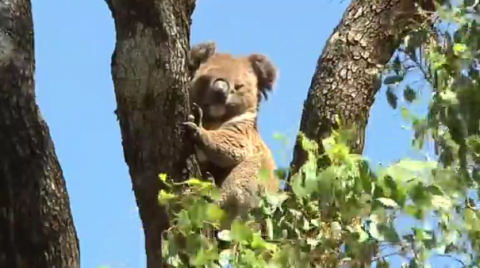
SYDNEY, Australia (Reuters) — Thirty kilometers (18.6 miles) south of the outback New South Wales town center of Gunnedah, semi-retired farmer Robert Frend is hoping to save an Australian icon, the koala, from dying of thirst.
The marsupials are known to get their water from chewing on eucalyptus leaves. But in 2009, 25 per cent of the koala population in Gunnedah – the self-proclaimed “koala capital of the world” was lost due to a heatwave. Causes of death were thirst, loss of habitat, and the sexually-transmitted disease chlamydia, which researchers suspect is also linked to a lack of water in their bodies.
Since then, numbers have continued to fall.
Frend, a third-generation cattle and grain farmer, noticed that, and at the end of 2015, he proposed to the University of Sydney to construct water stations that he especially designed for the koalas, prompting the world’s first study into providing water for koalas.
Named after the fictional children’s koala character “Blinky Bill” created by author and illustrator Dorothy Wall, the “Blinky Drinker” helps to supplement koalas’ diet with water.
The functional “tree drinker” setup includes an automatic drinking bowl strapped to a tree, which is fed by a hose with water from a 20-liter water drum. A flap over the bowl covered in gauze prevents lizards and insects from getting stuck in the water and potentially contaminating the supply.
Above the drinkers are mounted surveillance cameras to record the animals visiting and the time spent at the drinkers.
When footage emerged that koalas were indeed drinking from these stations, Frend said he was surprised.
“I’d always believed that koalas get all their moisture from the leaves. I mean, they have been living here since the 1970s without any water supplementation. There might have been the odd dam around about but to see them in this area where there just isn’t any water was certainly a shock and an eye-opener,” he said.
Valentina Mella, a postdoctoral researcher at the University of Sydney’s School of Life and Environmental Sciences, said the vulnerable species in Gunnedah were found to be thirsty, drinking from the “Blinky Drinkers” for an average of more than 10 minutes even during the winter in August last year.
She says while the research is still in its early stage, it’s likely the cause is climate change.
“I think the most important thing for me is to bring attention to the fact that climate change is making an impact and that we are talking about an Australian icon and everybody around the world knows koalas and we don’t want to lose koalas,” said Mella.
Working together, Frend and Mella want to create a flat-pack design for the drinkers, making the design more accessible and easy for farmers and land owners to install on their land.
“I’m a big kid too when it comes to koalas, I think they’re a lovely animal and I’d hate to see them disappear from, from this property and from the district because we as society didn’t make an effort or if I can help, well I get a certain amount of enjoyment out of that. Yeah, they’re a lovely species,” says Frend.
The koala was listed as “vulnerable” under the Environmental Protection and Biodiversity Conservation Act in 2012. The Australian Koala Foundation estimates that there are less than 100,000 koalas left in the wild, with possibly as few as 43,000.
The next step for Mella and her researchers is to monitor and calculate the findings from the 2016/2017 summer season from December-February, which will likely see koalas thirstier than the winter season.
According to a report published by the independent Climate Council on March 8, much of Australia’s east coast endured its hottest summer on record, responsible for breaking more than 200 Australian weather records between Dec. 1 and Feb. 28.








